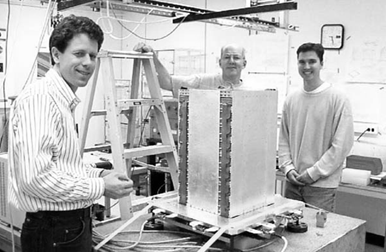
Prototype GLAST tower module built in SCIPP labs and
tested at SLAC
Gamma-ray Large Area Space Telescope (GLAST)
We are living in a time during which rapid and accelerating advances are being
made in astronomy and astrophysics, largely fueled by tremendous advances in
instrumentation available for observation of the universe. Not only are many large new
terrestrial telescopes coming on line, allowing us to see ever deeper into space, but also
the whole of the electromagnetic spectrum has been put at our disposal by the advent of
orbiting observatories. Observations in the far infrared, ultraviolet, x-ray, and gamma-
ray domains have already resulted not only in the discovery of new phenomena but also
in greatly improved capabilities for understanding the universe through multi-wavelength
observations. Sources that emit copious fluxes of gamma rays typically involve the
highest concentrations of energy anywhere and are often some of the most exciting and
enigmatic astrophysical objects. They include neutron-star pulsars, active galactic nuclei
(presumably powered by massive black holes), and gamma-ray bursts. GLAST will be a
large observatory capable of studying thousands of such sources in the energy range from
20 MeV up to many GeV, with a sensitivity 10 to 100 times better than possible before.
GLAST will detect gamma rays by converting them into an electron-positron pair.
A tracker based on silicon-strip detectors will measure the photon direction, and a
cesium-iodide calorimeter will measure the energy. The SCIPP group is working with
physicists and engineers at SLAC and in Japan to build the tracker subsystem, with
SCIPP responsible for all of the electronics design and fabrication, plus other work on
assembly, testing, software development, and management. Students, both undergraduate
and graduate, are involved in the development work, and excellent opportunities are
available to learn about designing an experiment to operate in a unique environment. At
present a fully functional prototype instrument is being built to operate in accelerator test
beams and, possibly, a balloon flight. The completed observatory is scheduled to be
launched by NASA in 2005.
SCIPP contact: Robert P. Johnson

